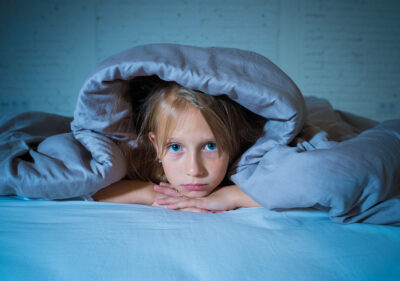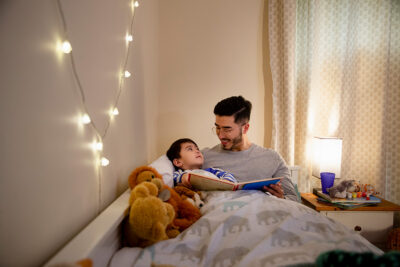
There’s no greater joy than bringing your baby home from the hospital. But make no mistake; your little one isn’t coming home to sleep. Through no fault of their own, babies have the most erratic sleep schedule known to man. So understandably, the motivation to sleep train them comes early.
While most parents will start the process of sleep training with the best of intentions, sometimes things don’t go quite as planned. One night of buckling to your little ones’ demands quickly turns into two and then three. Each night bleeds into the next, habits form, and before you know it, that tiny baby is four, bedtime is bananas (for everyone), and sleep training feels like a pipe dream.
Macall Gordon, M. A. and Sr. Lecturer for the Dept. of Applied Psychology at Antioch University, Seattle, lays bare the good news and the bad news: The bad news: “Once children move to a bed and gain the cognitive skills to start testing what they can make happen with their brain….well, it’s a recipe for a three-ring circus.” The good news: “Getting ahead of the bedtime circus can be done, and it’s never too late to work on sleep skills.”
What Is Sleep Training?
According to Christine Brown, Lead Child Sleep Consultant and founder of Bella Luna Family, “Sleep training is teaching children to learn to fall asleep independently and return to sleep independently unless they have a need. It is prioritizing your child’s and your need for sleep.”
Why Some Older Kids Need Sleep Training
For the most part, children are usually sleep trained by 12-18 months. In some cases, however, sleep training doesn’t “take” for any number of reasons, and parents may find themselves trying to sleep-train an older child.
Brown tells Sleepopolis that many parents who come to Bella Luna Family “sleep trained their child when they were younger, but something happened along the way, and they began doing a lot of ‘helping’ their child to sleep again. Oftentimes, sickness, travel, schedule adjustments, or fears can derail sleep and make it difficult to get back on track.” She also notes that some families choose not to sleep train their children when they’re younger in hopes that they’ll outgrow their sleep issues, which doesn’t always happen.
Nicole Johnson, pediatric sleep consultant and founder of The Baby Sleep Site, tells Sleepopolis, “Older children might also need sleep training if habits have been created that causes a dependency on a parent’s presence or a certain activity, such as rubbing their back.” “
“Most older children possess the capability of going to sleep independently, but they may not BELIEVE they can because of habits that have been created,” she says.
How To Sleep Train Older Kids
As you might have guessed, common baby sleep training methods like letting your child cry it out or bedtime fading won’t work here for the simple fact that your child is simply too old for those methods. And Brown tells us just as much, noting that “sleep training older children focuses a lot on behavior modification techniques, plus using positive parenting tools, like boundary setting, positive reinforcement, and logical consequence.”
Dr. Lynelle Schneeberg, a licensed clinical psychologist, and author of Become Your Child’s Sleep Coach: The Bedtime Doctor’s 5-Step Guide, Ages 3-10, says of the process, “Older kids are much harder to sleep train because they are not contained by a crib and because they can walk and talk (and let you know exactly how they feel about the sleep training plan!).”
To help parents find a way forward (and get back to bed), Schneeberg outlines a five-step plan in her book for sleep training older kids, which includes:
Creating A Consistent Bedtime Routine

Research has shown that bedtime routines not only promote healthy sleep, but they also help develop a sense of well-being in early childhood. And when sleep training children at any age, a consistent bedtime routine can be infinitely helpful.
Common cues for bedtime often include baths, turning off devices and television, reading, and dimming the lights. When these cues are repeated night after night as part of your child’s bedtime routine, they’ll eventually signal your child that it’s time for bed. Moreover, your child will begin associating these cues with bedtime, which is what you want.
Preparing The Bedroom For Great Sleep
In their efforts to contain the chaos, most parents use their child’s room as a multipurpose space. While they expect their child to sleep in their room, chances are parents also expect their child to play in that space, and some even use their child’s room for time-outs and punishments. But if you want your child to sleep in their room on their own you have to make it a safe, comfortable space for them to do so.
Parents can start by removing electronics (if they’re used during the day, remove them at night), clearing away the clutter, and resisting the urge to use their child’s room for punishment. The latter will only establish a negative association with their room and stymie any sleep training efforts.
Teach The Child To Self-Soothe
The key to sleep training is teaching your child to self-soothe and go back to sleep on their own if they wake.Remember, even adults wake up during the night, so this is a critical skill your child will carry with them throughout their lives.
Schneeberg notes that self-soothing for older kids may look a bit different and require a quiet activity, but that’s ok. “You have to give an older child ‘something to do’ while they are learning to self-soothe,” she says. With kids who are too young to be left unattended, this process would look like giving them “books, toys, a drawing pad, or picture books while the parent sits quietly in the room and gradually works their way out of the room in steps.”
Have A Way To Set Limits After Lights Out
“Try to find a way to give your child what they want, but set limits and build it into their routine,” says Johnson. “For example, if they want you to lay in bed with them, do so, but only as a part of the routine — have an ‘end’ to it just like you would need to have an ‘end’ to a visit to the park.”
Have A Plan For What To Do When The Child Wakes At Night
Schneeberg notes that children will wake up during sleep training, so parents should show up to the process with a plan for handling those disruptions.
Beyond making behavioral modifications and tweaking your child’s sleep hygiene, Schneeberg says parents should also think about breaking bad habits and addressing any fear their child might have.
Breaking Sleep Associations
Very often, older kids can’t (or won’t) sleep on their own and self-soothe because of established sleep associations or bad habits. Schneeberg says, “Whatever a child needs to GET to sleep, they will need that again to get BACK to sleep (a parent lying with them, having their back rubbed, and so on).” So, the key here is to break those associations. Ultimately, parents have to show their child that they can fall asleep without parental intervention.
Alleviating Fears
When sleep training older kids, remember that active imaginations may also play a role in a child’s reluctance to go it alone. If that’s the case, carve out some time before bed each night to discuss and put those fears to bed for your kids.
Sleep Training Tips From The Experts
Consistency Is Key
Brown tells Sleepopolis that consistency and communication are key. “If your words and actions don’t align and you don’t follow a plan, it will be nearly impossible to make long-term changes,” she says. She also advises parents “to communicate the changes that are coming in advance and give your child the opportunity to express their concerns and feelings during the day, so when bedtime comes, they know what to expect.”
Pick Your Battles
“One mistake we see a lot is power struggles that aren’t necessary,” says Johnson. “Do you really care if they brush their teeth before they put on their pajamas? If your child wants to do something that deviates from the plan, ask yourself if it really matters.” Johnson reminds parents that their “kids want a voice, too, so give it to them as much as possible while also keeping your routines consistent.”
Manage Your Expectations
Sleep training is a process, and — pardon the pun — it doesn’t happen overnight. “Parents think that they can sleep train older kids by just deciding they are too old to need a parent to stay with them, but this pattern has been in place for years, so it takes some time and planning to accomplish,” says Schneeberg.
Who Can Help Sleep Train Older Children?
For families who live under one roof, sleep training is likely a family affair. Co-parents can (and should) lean on each other, and older siblings may even be able to help.
“But, if you feel like you’ve tried everything and you can’t make positive, long-lasting changes, consider consulting with a sleep expert that works with older children,” says Brown. “It isn’t hopeless, and sleep consultants that specialize in older children will have the tools to help your family get the rest that you all need.”
When To Consult A Doctor
In most cases, sleep training is a behavioral issue, not a physical one, but Johnson notes that “If you have any concerns about your child’s physical health, developmental delays, or extreme behavior issues, you may want to share those with your doctor.”
The Last Word from Sleepopolis
Sometimes, despite their best efforts, parents may find themselves with an older child in need of sleep training. And while the methods typically used with babies won’t work with older kids, it can be done. The keys to your success lie in breaking bad associations, tweaking your child’s sleep hygiene, and making a few behavioral modifications.



























